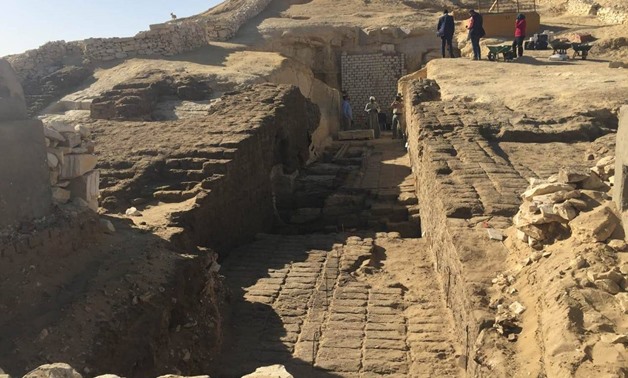
The joint team of the Ministry of Antiquities and the University of Alabama in Birmingham (UAB), the United States, finished the documentation, mapping and 3D topographic survey at Lisht necropolis area, Giza-Ministry of Antiquities' official Facebook pag
CAIRO – 30 August 2018: The joint team of the Ministry of Antiquities and the University of Alabama in Birmingham (UAB), the United States, finished the documentation, mapping and 3D topographic survey at Lisht necropolis area, Giza, according to the Ministry of Antiquities’ statement on Wednesday.
 The joint team of the Ministry of Antiquities and the University of Alabama in Birmingham (UAB), the United States, finished the documentation, mapping and 3D topographic survey at Lisht necropolis area, Giza-Ministry of Antiquities' official Facebook page
The joint team of the Ministry of Antiquities and the University of Alabama in Birmingham (UAB), the United States, finished the documentation, mapping and 3D topographic survey at Lisht necropolis area, Giza-Ministry of Antiquities' official Facebook page
The Head of the Central Administration for Cairo and Giza Antiquities, Adel Okasha, said that 802 tombs from Egyptian Middle Kingdom were documented.
 The joint team of the Ministry of Antiquities and the University of Alabama in Birmingham (UAB), the United States, finished the documentation, mapping and 3D topographic survey at Lisht necropolis area, Giza-Ministry of Antiquities' official Facebook page
The joint team of the Ministry of Antiquities and the University of Alabama in Birmingham (UAB), the United States, finished the documentation, mapping and 3D topographic survey at Lisht necropolis area, Giza-Ministry of Antiquities' official Facebook page
He added that the archaeological survey is vital as it provides more information about the Middle Kingdom cemeteries including social hierarchy, religious rituals, and the daily life of Egypt’s capital ‘Itj Tawy’ during the Middle Kingdom, known currently as Lisht.
 The joint team of the Ministry of Antiquities and the University of Alabama in Birmingham (UAB), the United States, finished the documentation, mapping and 3D topographic survey at Lisht necropolis area, Giza-Ministry of Antiquities' official Facebook page
The joint team of the Ministry of Antiquities and the University of Alabama in Birmingham (UAB), the United States, finished the documentation, mapping and 3D topographic survey at Lisht necropolis area, Giza-Ministry of Antiquities' official Facebook page
Since 2012, the Ministry of Antiquities has been documenting Egypt’s cultural and archaeological sites using state-of-the-art equipment and modern technology to protect and preserve them as well as provide comprehensive detailed studies on every site, but it stopped after the January 25th revolution due to financial problems.
The documentation was resumed in 2017 and started with Esna Temple and the Tanis site.
Most recently, the Ministry of Antiquities launched a project to document all the archaeological inscriptions across Egypt, particularly in Sinai’s valleys, Aswan, the Eastern and Western desert.




Comments
Leave a Comment